|
|
 |
Fiche d'espèce de Copépode |
|
|
Calanoida ( Ordre ) |
|
|
|
Clausocalanoidea ( Superfamille ) |
|
|
|
Scolecitrichidae ( Famille ) |
|
|
|
Scottocalanus ( Genre ) |
|
|
| |
Scottocalanus helenae (Lubbock, 1856) (F,M) | |
| | | | | | | Syn.: | Undina Helenae Lubbock,1856; Giesbrecht, 1892 (p.302); Giesbrecht Schmeil, 1898 (p.52);
Scolecithrix securifrons (M) T. Scott, 1894 b (p.47, figs.); Giesbrecht & Schmeil, 1898 (p.49); van Breemen, 1908 a (p.76);
Scottocalanus australis Farran, 1936 a (p.101, figs.F, Rem); Sewell, 1948 (p.541, 553, Rem.); Tanaka, 1961 a (p.146, figs.F); Paiva, 1963 (p.48, figs.F); Owre & Foyo, 1967 (p.63, figs.F); Vives, 1972 (p.215, 216, figs.F); Björnberg, 1973 (p.333, 389); Vives & al., 1975 (p.43, tab.II); Deevey & Brooks, 1977 (p.256, tab.2, Station "S"); Vives, 1982 (p.292); He & al., 1992 (p.250); Gopalakrishnan & Balachandran, 1992 (p.167, fig.7, Table 1, 2); Guangshan & Honglin, 1984 (p.118, tab.); Suarez, 1992 (App.1); Shih & Young, 1995 (p.73); Lopez-Salgado & al., 2000 (tab.1); Hernandez-Trujillo & Esqueda-Escargera, 2002 (in Appendix);
? Scottocalanus helenae : Chiba, 1956 (p.54, figs.M);
no S. helenae : A. Scott, 1909 (p.111); Sewell, 1929 (p.183); Mori, 1937 (1964) (p.49, figs.M); Sewell, 1947 (p.143); C.B. Wilson , 1950 (p.338, figs.M); ? Shih & Chiu, 1998 (p.538); Hsiao & al., 2004 (p.326, tab.1);
No Scottcalanus helenae : Tanaka, 1961 a (p.140, 143, figs.F, M, Rem.M) | | | | Ref.: | | | ? C.B. Wilson, 1950 (p.338, fig.F); Chiba & al., 1957 (p.308); 1957 a (p.11); Paiva, 1963 (p.47, fig.M); Vervoort, 1965 (p.45, figs.F,M, Rem.); Owre & Foyo, 1967 (p.63, figs.F,M); Morris, 1970 (p.2301, 2306, figs.F); Park, 1970 (p.476); Bradford, 1973 (p.141: Rem.); Park, 1983 (p.198, 199, 205, figs.F,M, Rem.); Bradford & al., 1983 (p.115, 116, figs.F,M, Rem.); Chihara & Murano, 1997 (p.902, Pl.177: F,M); Mulyadi, 1998 a (p.385, Redescr.M, figs.M); Mulyadi, 2004 (p.27, figs.M, Rem.); Vives & Shmeleva, 2007 (p.808, figs.F,M, Rem.) |  issued from : Mulyadi in The Raffles Bull. Zool., 1998, 46 (2). [p.384, Fig.2]. Male: a, last thoracic segment and urosome (dorsal); b, forehead (right lateral side); c, last thoracic segment and urosome ( right lateral side); d, rostrum (frontal view); e, P2; f, P3; g, P5; h, distal segment of right P5. Nota: The male most closely resembles that of S. thori (With,1915), but is distinguishable from the latter.
|
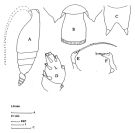 issued from : J.M. Bradford, L. Haakonssen & J.B. Jillett in Mem. N.Z. Oceanogr. Inst., 1983, 90. [p.117, Fig.72]. Female: A, habitus (lateral left side); B, genital segment (dorsal); C, rostrum; D, endopod of P2; E, P5; F, P5 (different specimen from another station). Nota: The south-west Pacific specimens show the posterior margins of urosome segments 1-3 with a thin, transparent, striated fringe (rather than teeth).
|
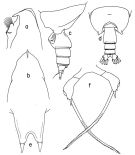 issued from : T. Park in Antarct. Res. Ser. Washington, 1983, 38 (3). [p.206, Fig.23]. Female: a, forehead (lateral); b, idem (dorsal); c, last thoracic segments and urosome (lateral left side); d, idem (dorsal); e, rostrum (anterior); f, P5 (anterior). Nota: Urosome about 22/100 length of prosome. A1reaching close to distal end of caudal ramus. All cephalosomal appendages similar to those of S.securifrons
|
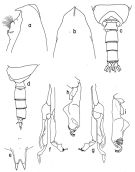 issued from : T. Park in Antarct. Res. Ser. Washington, 1983, 38 (3). [p.207, Fig.24]. Male: a, forehead (lateral); b, idem (dorsal); c, last thoracic segments and urosome (dorsal); d, idem (lateral left side); e, rostrum (anterior); f, P5 (anterior); g, P5 (right posterior); h, distal part of left P5 (medial); i, distal part of left P5 (lateral). Nota: Urosome about 36/100 length of prosome. A1 reaching close to distal end of 4th urosomal segment. All cephalosomal appendages and P1 to P4 as in S. securifrons.
|
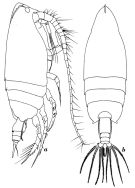 Issued from : W. Vervoort in Atlantide Report, 1965, 8. [p.46, Fig.7] Female (from Canary Is.-Cape Verde Is.): a, habitus (lateral right side); b, idem (dorsal). Nota: Head and 1st thoracic segment fused, 4th and 5th fused. Head with a helmet-shaped crest, apex rounded. At the base of the rostral plate, on each side, a distinct rounded \"eye spot\". A1 24-segmented (segments 8 and 9 fused)
|
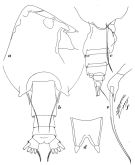 Issued from : W. Vervoort in Atlantide Report, 1965, 8. [p.48, Fig.8] Female: a, forehead (lateral); b, posterior part cephalothorax and urosome (dorsal); c, idem (lateral right side); d, rostrum (ventral view); e, P5; f, apex of P5. Nota: 4th and 5th thoracic somites fused, backwardly produced into a rounded lappet, covering the beginning of the genital somite; the lateral thoracic border is strictly rounded or it may be mucronated or even spinelike produced; in dorsal aspect there are slightly laterally directed, rounded lappets (see in fig.8b). Proportional lenths of urosomal somites and caudal rami 44:18:12:8:18 = 100. The external margin of the caudal rami haired.
|
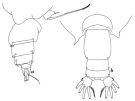 Issued from : W. Vervoort in Atlantide Report, 1965, 8. [p.49, Fig.9] Female: a, posterior part cephalothorax and urosome (lateral right side); b, idem (dorsal). Nota: The urosomal segments and furca in the proportional lengths 44:18:12:8:18 = 100. The external margin of the furcal rami is haired.
|
 Issued from : W. Vervoort in Atlantide Report, 1965, 8. [p.75, Fig.17] abnormal female: c, posterior part cephalothorax and urosome (lateral left side).
|
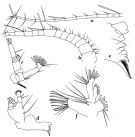 Issued from : W. Vervoort in Atlantide Report, 1965, 8. [p.50, Fig.10] Female: a-b, A1; c, A2; d, Md; e, Md (cutting edge); f, Mx1. Nota: A1 24-segmented segments8 and 9 fused). Mxi with lengthened praecoxal arthrite, carrying 9 strong setiform spines and 3 additional setae; epipodite with 7 strong and 2 weaker setae; coxal endite with 2 setae; basal endite well developed with 3 setae; no basal exite; endopodite and basipodite fused, with 5 setae on the basipodite and 7 setae on endopodite; exopodite small, with 8 setae.
|
 Issued from : W. Vervoort in Atlantide Report, 1965, 8. [p.52, Fig.11] Female: a, P1; b, P2 (anterior); b', P2 (posterior surface of endopodite); c, P3 (anterior); c', P3 (posterior surface of endopodite); d, P4 (anterior); e, Mxp; f, Mx2. Nota: Mx2 is a small, compactly built structure; praecoxa and coxa imperfectly separate, each with 2 endites, bearing 3, 3, 3 and 4 setae respectively; basipodite with a large endite, contiguous with a strong curved spine, at the base of which there are 2 small setae; the three segments of endopodite distinctly separate, there are 6 elongated sensory brushes on endopodite
|
 Issued from : W. Vervoort in Atlantide Report, 1965, 8. [p.53, Fig.12] Male: a, forehead (lateral); b, rostrum (ventral view); c, posterior part cephalothorax and urosome (dorsal); d, idem (lateral right side); e, right furcal ramus (ventral). Nota: The urosomal segments and furca in the proportional lengths 16:27:21:23:6:7 = 100. Genital segment asymmetrical by the development, on the left side, of the genital orifice (a very prominent slit). Very distinct, scale-shaped teeth along the distal border of urosomal segmets 2 and 3, the distal margin of 4th urosomal segment with some big teeth and some smaller scales in the vicinity of the bigger teeth. Anal segment very short, anal plate small
|
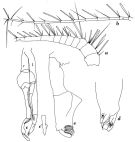 Issued from : W. Vervoort in Atlantide Report, 1965, 8. [p.55, Fig.13] Male: a-b, A1; c, P5 (l = left leg; r = right leg); c', apex of left P5 (slightly inverted position); d, apex of left P5; e, exopodite of left P5. Nota: A1 21-segmented (segments8 and 9, 10 to 13 fused)
|
 Issued from : G.P. Farran in Great Barrier Reef Expedition 1928-1929, Scient. Rep., V, N°3, 1936. [p.101, Fig.13]. As Scottocalanus australis. Female: a, habitus (dorsal); b, forehead (lateral); c, last thoracic segment and abdomen (lateral); d, rostrum; e, P5.
|
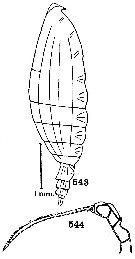 issued from : C.B. Wilson in U.S. National Museum. Bull.100, 14 (4), 1950. [Pl.36, Figs.543, 544]. With doubt. Female (from Philippines): 543, habitus (lateral right side); 544, P5. Nota: Head and 1st thoracic segment fused (the separation indicated by a very short dorsal groove), 4th and 5th separated, the latter with short acute spines at the posterior corners, which overlap the genital segment a little. Head with a prominent frontal crest. Urosome 4-segmented; in lateral view each segment projects at its posterior margin above the following segment. Genital segment nearly as long as the three abdominal segments combined and is sligtly protuberant ventrally. Anal segment very short and scarcely visible in dorsal view. Caudal rami about twice as long as wide, and strongly divergent. Exopod of A2 much longer than endopod, and the end segment about as long as the 2nd segment.
|
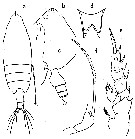 issued from : O. Tanaka in Publ. Seto Mar. Biol. Lab., 1961, IX (1). [p.146, Fig.108]. As Scottcalanus australis. Female: a, habitus (dorsal); b, forehead (lateral); c, last thoracic segment and urosome (lateral, left side); d, rostrum (frontal view); e, P2; f, P5.
|
 issued from : H.B. Owre & M. Foyo in Fauna Caribaea, 1, Crustacea, 1: Copepoda. Copepods of the Florida Current. [p.62, Figs.394-395]. As Scottocalanus australis. Female: 394, rostrum; 395, P5. Nota: Terminal projections of the rostrum shorter than the depth of the rostral excavation and not bifurcated at the tip; length of terminal projections approximately half the depth of the excavation between the two parts of the rostrum.
|
 issued from : H.B. Owre & M. Foyo in Fauna Caribaea, 1, Crustacea, 1: Copepoda. Copepods of the Florida Current. [p.61, Figs.389, 390]. As Scottocalanus australis. After Farran (1936). Female: 389, habitus (dorsal); 390, last thoracic segment with P5 and urosome (right lateral). Nota: Posterior corners of the last thoracic segment neither extended posteriorly nor pointed (Fig.390).
|
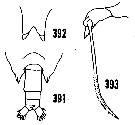 issued from : H.B. Owre & M. Foyo in Fauna Caribaea, 1, Crustacea, 1: Copepoda. Copepods of the Florida Current. [p.61, Figs.391-393]. Female: 391, last thoracic segment and urosome (dorsal); 392, rostrum; 393, P5. Nota: Posterior corners of the last toracic segment extended posteriorly and distinctly pointed (Fig.391).
|
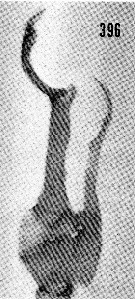 issued from : H.B. Owre & M. Foyo in Fauna Caribaea, 1, Crustacea, 1: Copepoda. Copepods of the Florida Current. [p.62, Fig.396]. Male: 396, right P5. Nota: Posterior corners of prosome rounded. Terminal projections of the rostrum about as long as the depth of the rostral excavation and not bifurcated.
|
 issued from : B. Morris in J. Fish. Res. Bd Canada, 1970, 27 (12). [p.2308, Fig.5). Female (from subtropical North Pacific): A, habitus (lateral); B, forehead (lateral); C, posterior prosome and genital segment (lateral); D, same (dorsal); E, rostrum (anterior); F, A2; G, Md (mandibular palp); H, Mx2; I, Mxp; J, P1; K, P2 (anterior); L, P5 (anterior); M, terminal segment of P5 (anterior); N, same (lateral).
| | | | | Ref. compl.: | | | Sewell, 1948 (part., p.329, 501, 521, 546); Grice & Hulsemann, 1965 (p.224); 1967 (p.17); Furuhashi, 1966 a (p.295, vertical distribution in Kuroshio region, Table 10); Fleminger, 1967 a (tabl.1); Bainbridge, 1972 (p.61, Appendix Table III: occurrence); Roe, 1972 (p.277, tabl.1, tabl.2); 1972 b (p.531, Rem.); Deevey & Brooks, 1977 (p.256, tab.2, Station "S"); Carter, 1977 (1978) (p.35); Dessier, 1979 (p.205); Vives, 1982 (p.292); Brenning, 1984 (p.4, Rem.); Cummings, 1984 (p.163, Table 2); ? Guangshan & Honglin, 1984 (p.118, tab.); Brenning, 1985 a (p.28, Table 2); Rudyakov, 1986 (tab.1); Lozano Soldevilla & al., 1988 (p.59); Cervantes-Duarte & Hernandez-Trujillo, 1989 (tab.3); Suarez & al., 1990 (tab.2); Hernandez-Trujillo, 1991 (1993) (tab.I); Suarez, 1992 (App.1); Gopalakrishnan & Balachandran, 1992 (p.167, fig.7, Table 1, 2); Shih & Young, 1995 (p.73); Suarez-Morales & Gasca, 1998 a (p.111); Lapernat, 2000 (tabl.3, 4); Lo & al., 2004 (p.89, tab.1); ? Kuriyama & Nishida, 2006 (p.293, 300: Tab.II, fig.7, 10, vertical distribution, Rem.: p.313); Fernandes, 2008 (p.465, Tabl.2); Lan Y.-C. & al., 2008 (p.61, Table 1, % vs stations);Park & Ferrari, 2009 (p.143, Table 5, Appendix 1, biogeography); ? C.-Y. Lee & al., 2009 (p.151, Tab.2); in CalCOFI regional list (MDO, Nov. 2013; M. Ohman, comm. pers.); Sano & al., 2013 (p.11, Table 2, 5, A1, figs.8, 9, feeding habits, vertical distribution); El Arraj & al., 2017 (p.272, table 2, seasonal composition); | | | | NZ: | 10 + 1 douteuse | | |
|
Carte de distribution de Scottocalanus helenae par zones géographiques
|
| | | | | | | | |  Issued from : M. Sano, K. Maki, Y. Nishibe, T. Nagata & S. Nishida in Progr. Oceanogr., 2013, 110. [p.20, Fig.10]. Issued from : M. Sano, K. Maki, Y. Nishibe, T. Nagata & S. Nishida in Progr. Oceanogr., 2013, 110. [p.20, Fig.10].
Vertical distribution of eight copepod species across 0-1000 m in Sagami Bay in 21-27 April 2009.
White and black boxes denote daytime and nighttime distributions. Scaphocalanus echinatus is taken from Kuriyama & Nishida (2006).
Plankton and water samples collected from a fixed station (35°00'N, 139°20'E) using MTD horizontal closing nets (0.33 mm mesh aperture) at 15 depths (0, 50, 95, 100, 150, 195, 200, 295, 300, 395, 400, 500, 600, 800, 1000 m) during both day and night.
Atomic C:N (mean ± SD) = 4.8 ±0.3, n = 15. |
 Issued from : M. Sano, K. Maki, Y. Nishibe, T. Nagata & S. Nishida in Progr. Oceanogr., 2013, 110. [p.19, Figs.8, 9]. Issued from : M. Sano, K. Maki, Y. Nishibe, T. Nagata & S. Nishida in Progr. Oceanogr., 2013, 110. [p.19, Figs.8, 9].
Second maxilla (Mx2) and maxilliped (Mxp) from Scaphocalanus echinattus (e), Scottocalanus helenae (f) and Scottocalanus securifrons (g).
Scale bars: Mx2 = 100 µm (e, f); 200 µm (g); Mxp = 100 µm (e); 200 mm (f, g).
Nota: The setae in Sco. securifrons, Sco. helenae, and Sca. echinatus were similar in shape to specialized chemosensory setae; among these, the shape in Sca. echinatus were relatively fine.
The feeding appendages (Mx2 and Mxp) do not appear suitable for feeding on fine particulate organic material (POM) contrary to Scaphocalanus echinatus (Compare figures of setal armament from three species in the two genera). It is assumed that the contribution of zooplankton prey to this species is larger than that the other species (Scottocalanus securifrons and Scaphocalanus echinatus). The stable-isotope ratios (C and N) values of S. helenae were close to those of carnivorous zooplankton (chaetognaths, Paraeuchaeta tuberculata). Differences in the C and N values between S. helenae and Calanus sinicus were 2.6% and 0.1%, suggesting that C. sinicus may be a potential food of S. helenae. Sco. helenae, as Sco. securifrons had short, stout setae on Mxp. |
| | | | Loc: | | | South Africa (E), Congo, G. of Guinea, off Lagos, Cape Verde Is., off Mauritania-NW Cape Verde Is., off Moroccan Atlantic Coast,, Canary Is., off Madeira, Ibero-moroccan Bay, Caribbean Sea, G. of Mexico, Florida, off Bermuda: Station ‘’ S’’ (32°10’N, 64°30’W), Sargasso Sea, Indian (Natal), Bay of Bengal, 10° N - 20° S ( in Gopalakrishnan & Balachandran, 1992), Flores Sea, ? Philippines, China Seas (Yellow Sea, East China Sea, South China Sea, in W. Zhang & al., 2010) , ? Taiwan, 25°30'N-123°E , ? Japan (Sagami Bay, SW Bösö), ? Bikini Is., ? Pacif. (central subtropical N), Pacif. (W equatorial), Australia (Great Barrier), New Zealand, ? off N Hawaii, California, W Baja California, Chile | | | | N: | 64 ? | | | | Lg.: | | | (9) F: 4,1-3,18; (16) F: 3,85-3,35; M: 3,95-3,8; (34) F: 3,96; (73) M: 4,05; ? (73') F: 4,1; 3,9; (92) F: 3,72-3,6; (199) F: 3,88-3,57; M: 3,95-3,8; (777) M: 3,86; (866) F: 3,92-4,4; M: 4,12-4,81; ? (1000) F: 4,3 ± 0,1; M: 4,4 ± 0,1; (1111) F: 4,07-3,95; M: 3,95; (1122) M: 3,86; {F: 3,18-4,40; M: 3,80-4,81} | | | | Rem.: | épi-bathypélagique.
Espèce souvent confondue à d'autres, d'où une distribution géographique peu sûre.
Vervoort (1965) considère S. australis comme synonyme de cette forme, suivi par Mulyadi (1998 a, p.385), contrairement à Farran (1936 a), Tanaka (1961 a), Owre & Foyo (1967), Vives (1982, Suarez (1992 et Suarez-Morales & Gasca, (1998 a).
Cette forme serait essentiellement atlantique et S. australis indo-pacifique.
Voir aussi les remarques en anglais | | | Dernière mise à jour : 25/10/2022 | |
|
|
 Toute utilisation de ce site pour une publication sera mentionnée avec la référence suivante : Toute utilisation de ce site pour une publication sera mentionnée avec la référence suivante :
Razouls C., Desreumaux N., Kouwenberg J. et de Bovée F., 2005-2025. - Biodiversité des Copépodes planctoniques marins (morphologie, répartition géographique et données biologiques). Sorbonne Université, CNRS. Disponible sur http://copepodes.obs-banyuls.fr [Accédé le 22 octobre 2025] © copyright 2005-2025 Sorbonne Université, CNRS
|
|
 |
 |

























